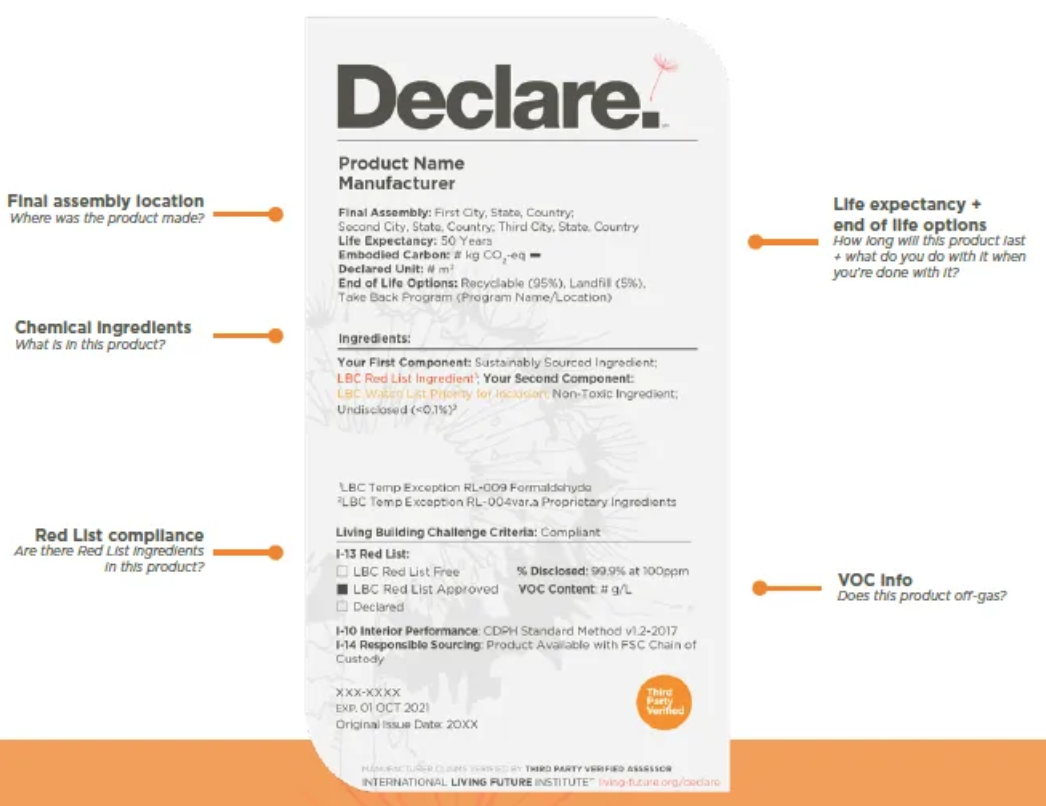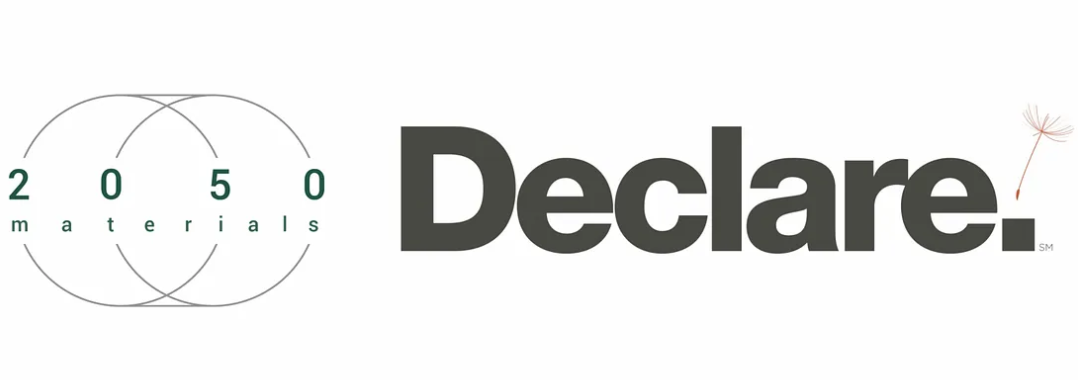Declare: The building product nutrition label

International Living Future Institute
The International Living Future Institute (ILFI) is a non-profit organization on a mission to build an ecologically minded, restorative world for humanity. Using principles of social and environmental justice, ILFI aims to facilitate the re-engineering of our cities and towns to correspond more directly to the natural landscapes they inhabit.
To achieve this, we need to create buildings that wean off the fossil fuel economy in the long-term.
The value of product-specific certifications
For almost two decades, ILFI runs the Living Building Challenge (LBC), a rigorous standard for green buildings. Living Buildings strive for net-zero or net-positive energy, are free of toxic chemicals, and lower their carbon footprint many times below the typical commercial structure. To successfully implement such measures, however, emphasis should be communicated through the design and specification process.
The Living Product Challenge (LPC) came to life to address this particular materiality aspect, it takes the principles of the ILFI building-wide certification (LBC) and applies them specifically to building products. The framework encourages manufacturers to create products that are healthy, inspiring and give more than they take across their life cycles.
Do specifiers understand toxicity concerns?
Understanding the true composition, as well as the impact of different chemicals making up any building products you specify can be a notoriously time-consuming and complex task. On top of that, many manufacturers themselves may not be fully aware of what nasty chemicals are lurking inside their products.
There are more than 85,000 different industrial chemicals in the world, and when considering the fact that the US bans fewer than 10 out of so many thousands, it’s simply extraordinary.
It is crucial for manufacturers and specifiers to be well informed about all the chemicals composing the building products or materials they manufacture and specify, which makes the Declare label an extremely powerful tool in the decision-making process.
Declare label — What is it?
Declare is a nutrition label for building products, designed to help specifiers identify products that meet their project requirements easily. It is a product transparency disclosure that enables a healthier, safer, greener and more ethical built environment.
Manufacturers get the opportunity to voluntarily disclose product information on easy-to-read Declare labels. These labels report all product ingredients through a simple color code system, flagging up chemicals of concern. In addition, further information is provided on manufacturing locations, end-of-life uses, life expectancy, and overall compliance with relevant requirements of building-wide certifications, such as:
- Living Building Challenge (LBC).
- International WELL Building Standard.
- US LEED, and more.
The label also includes the Red List status of the product. The Red List is a list of chemicals, materials and elements that ILFI believes should be phased out of production due to human / environmental health and toxicity concerns. These are chemicals that either pollute the environment, stick in the atmosphere for far too long, or pose a health risk to humans at all stages of the product’s lifespan.
The Red List status of the products means:
- Red List Free: Products that disclose 100% of product ingredients plus residuals present at or above 100 ppm (0.01%) in the final product and do not contain any Red List chemicals.
- Red List Approved: Products that meet the written requirements of the Living Building Challenge Red List Imperative, but rely on one or more Exceptions to demonstrate compliance. A minimum of 99% of product ingredients plus residuals present at or above 100 ppm (0.01%) in the final product are disclosed.
- Declared: Declared products disclose 100% of product ingredients plus residuals present at or above 100ppm (0.01%) in the final product, but contain one or more Red List chemicals that are not covered by an existing Exception.

Declare label: Explained
The case for Going-Green
The climate emergency is now a reality, having record-high temperatures and record-high CO2 levels in thousands of years. Efforts should be focused on manufacturing and specifying regenerative and healthy products, to ensure the resilience of the built environment and its positive impact on the planet.
As stated in the 2020 Economist Special Climate Report:
 De-carbonizing the economy holds many risks but it also offers plenty of opportunities. Firms that get ahead of their rivals will reap the biggest benefits.
De-carbonizing the economy holds many risks but it also offers plenty of opportunities. Firms that get ahead of their rivals will reap the biggest benefits.
Embracing transparency is a robust starting point to stay a step ahead, both from a manufacturing but also a design perspective. Manufacturers and specifiers have a critical role to play in the transition to a low carbon economy, and as decarbonization initiatives gain momentum, the only way to benefit from this growing trend is to integrate climate neutrality initiatives in the core processes of your business operations.
2050 Materials & Declare partnership
2050 Materials has partnered up with the International Living Future Institute to enhance the fight against climate change.
We are helping specifiers understand the impact of their design decisions through simplified data visualizations, while guiding manufacturers on their journey towards environmental transparency and client-engagement.
If you are a manufacturer trying to align your products with the climate emergency, you should opt for Declare (contact: declare@living-future.org) and be on 2050 Materials! It takes a few minutes to list a product, and ensures your products are visible in the latest sustainability and reporting tools specifiers are using.
Reach out to info@2050-materials.com to book a demo and get free listing access for the 2050 Materials beta.

Related articles

Climate-Resilient Materials for the Built Environment: A Data-Centred Prime
As climate volatility intensifies, resilience metrics are fast becoming as critical as carbon data in material selection. This article outlines why adaptation is now a design imperative, how materials can be evaluated through a systems lens, and what KPIs project teams should demand. From self-healing concrete to fire-rated façades, we present a structured taxonomy of resilient materials, explain how to embed this intelligence into digital design workflows, and propose next steps for specification, benchmarking, and procurement.
Read more
The Most Interesting Low Carbon Products in Office Design
In this article and collection, we highlight 11 outstanding products that contribute to a lower carbon footprint in office design.
Read more
Top Low Carbon Building Boards: Performance, Benefits, and Use Cases
The building boards highlighted in this article and collection showcase low-carbon innovation in modern construction.
Read more